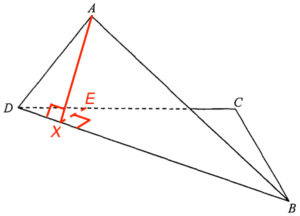- Consider $\Delta ABD$.
$\begin{array}{rcll}
\angle ADB & = & 180^\circ – 120^\circ – 20^\circ \\
\angle ADB & = & 40^\circ
\end{array}$By applying sine law to $\Delta ABD$, we have
$\begin{array}{rcl}
\dfrac{AB}{\sin \angle ADB} & = & \dfrac{AD}{\sin \angle ABD} \\
\dfrac{60}{\sin 40^\circ} & = & \dfrac{AD}{\sin20^\circ} \\
AD & = & 31.925\ 333\ 17\text{ cm}
\end{array}$ -
- By applying cosine law to $\Delta ABC$, we have
$\begin{array}{rcl}
\cos \angle ABC & = & \dfrac{AB^2 + BC^2 – AC^2}{2\times AB \times BC} \\
\cos \angle ABC & = & \dfrac{AB^2 + AD^2 – AC^2}{2\times AB \times AD} \\
\cos \angle ABC & = & \dfrac{60^2 + 31.925\ 333\ 17^2 – 40^2}{2\times 60 \times 31.925\ 333\ 17} \\
\cos \angle ABC & = & 0.788\ 095\ 899 \\
\angle ABC & = & 37.992\ 075\ 34^\circ
\end{array}$ - Add a point $X$ on $BD$ such that $AX \perp BD$. Add a point $E$ on $CD$ such that $EX \perp BD$.

Note that the required angle is $\angle AXE$.
Consider $\Delta ADX$.
$\begin{array}{rcl}
\sin \angle ADX & = & \dfrac{AX}{AD} \\
AX & = & 31.925\ 333\ 17 \times \sin 40^\circ \\
AX & = & 20.521\ 208\ 6\text{ cm}
\end{array}$Also,
$\begin{array}{rcl}
\tan \angle ADX & = & \dfrac{AX}{DX} \\
DX & = & \dfrac{20.521\ 208\ 6}{\tan 40^\circ} \\
DX & = & 24.456\ 224\ 07\text{ cm}
\end{array}$Consider $\Delta DEX$.
$\begin{array}{rcl}
\tan \angle XDE & = & \dfrac{EX}{DX} \\
EX & = & 24.456\ 224\ 07 \times \tan 20^\circ \\
EX & = & 8.901\ 337\ 605\text{ cm}
\end{array}$Also,
$\begin{array}{rcl}
\cos \angle EDX & = & \dfrac{DX}{DE} \\
DE & = & \dfrac{24.456\ 224\ 07}{\cos 20^\circ} \\
DE & = & 26.025\ 770\ 06\text{ cm}
\end{array}$Consider $\Delta ADE$. Note that $\angle ADE = \angle ABC$.
$\begin{array}{rcl}
AE^2 & = & AD^2 + DE^2 – 2 \times AD \times DE \times \cos \angle ADE \\
AE^2 & = & 31.925\ 333\ 17^2 + 26.025\ 770\ 06^2 – 2 \times 31.925\ 333\ 17 \times 26.025\ 770\ 06 \times \cos 37.992\ 975\ 34^\circ \\
AE & = & 19.670\ 769\ 9\text{ cm}
\end{array}$Consider $\Delta AXE$.
$\begin{array}{rcl}
\cos \angle AXE & = & \dfrac{AX^2 + XE^2 – AE^2}{2\times AX \times XE} \\
\cos \angle AXE & = & \dfrac{20.521\ 208\ 6^2 + 8.901\ 337\ 605^2 – 19.670\ 769\ 9^2}{2 \times 20.521\ 208\ 6 \times 8.901\ 337\ 605} \\
\angle AXE & = & 71.914\ 113\ 96^\circ
\end{array}$Therefore, the required angle is $71.9^\circ$.
- By applying cosine law to $\Delta ABC$, we have
2018-I-17
Ans: (a) $31.9\text{ cm}$ (b) (i) $38.0^\circ$ (ii) $71.9^\circ$

